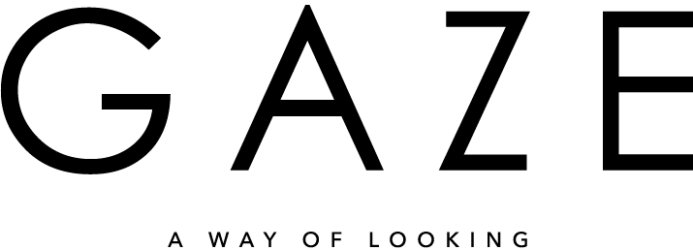Por Sheilla Cohen.
Jeppe Hein (Copenhague, Dinamarca, 1974) es ampliamente reconocido por su producción de obras experimentales e interactivas que combinan arte, arquitectura e invenciones técnicas. Único por su simpleza formal y uso del humor, su trabajo plantea un diálogo vivo con la tradición de la escultura minimalista y el arte conceptual de los setenta.
Las piezas de Hein suelen presentar elementos que vuelven al espectador en el centro de sus instalaciones y esculturas, y relativizan su experiencia distorsionando el espacio circundante –de ahí el uso recurrente de espejos–. Así mismo, en la superficie de sus icónicos globos especulares reafirma la idea de que nuestra mirada está en constante transformación.
Además de su producción anual de obras para ferias de arte, exposiciones y proyectos de arte público, en los últimos años se ha dedicado a Breath With Me, un proyecto de arte participativo para el mundo, en el que las personas pintan líneas de acuarela azul mientras hacen un ejercicio de respiración.
“La vida comienza con una inhalación y termina con una exhalación. En el medio, todos respiramos y vivimos vidas diferentes. Y, sin embargo, cada respiración nos mantiene juntos, conectados, compartiendo el mismo aire”.
A través de estos talleres de respiración con acuarela, el artista danés ha enseñado a personas de todo el mundo a conocer los beneficios de trabajar con ambas disciplinas para liberar la ansiedad, el estrés y la tensión que sufrimos por los tiempos de incertidumbre que vivimos en la actualidad, ayudándonos a anclarlos en el aquí y el ahora, viviendo en el presente. Las intenciones democráticas de Jeppe Hein son en gran medida que el arte contemporáneo se vuelva más accesible y reconfortante para todos, independientemente de sus conocimientos, jugando así más con nuestra percepción y apelando directamente a nuestras emociones.

Courtesy KÖNIG GALERIE, Berlin / London, 303 GALLERY, New York, and Galleri Nicolai Wallner, Copenhagen.
Photo: James Ewing, exhibited at Brooklyn Bridge Park, NYC, 2015, Courtesy Public Art Fund.
¿Cuándo decidiste que querías dedicarte al arte?
Vengo de una familia muy creativa y estaba rodeado de mucho arte y artistas. Cuando hice mi primera acuarela en 1991, me di cuenta de que hacer arte me daba una energía enorme. En ese momento fue cuando decidí convertirme en artista.
¿En qué momento supiste que la escultura y la instalación eran tu medio preferido?
Cuando creé y expuse mi primera instalación interactiva, Moving Wall #1, en 1999, en Frankfurt. Cuando vi cómo interactuaba la gente, cuanto querían comunicarse con la ayuda de mi obra de arte. Me hizo tan feliz que funcionó según lo previsto e incluso, mejor.
Tu trabajo se considera una mezcla de conceptualismo y minimalismo. ¿Cuáles son las principales influencias artísticas en tu trabajo?
Me han inspirado Dan Graham, Robert Morris, Robert Smithson, Larry Bell, Olafur Eliasson y Asger Jorn, porque todos trabajan con la comunicación y la experiencia. Sus obras siempre están físicamente presentes y son perceptibles; la gente no solo las puede mirar, sino que también las siente.
¿En dónde encuentras inspiración?
Necesitas una mente y un cuerpo libres para ser inspirado y creativo, lo que experimento cuando estoy lejos del mundo del arte, durante la meditación o cuando estoy en una lluvia de ideas con mi equipo.
¿Cómo crees que tanto tú como artista y persona han evolucionado a lo largo de los años?
Me di cuenta de que es importante estar aquí ahora mismo y que solo puedes cambiarte a ti mismo.
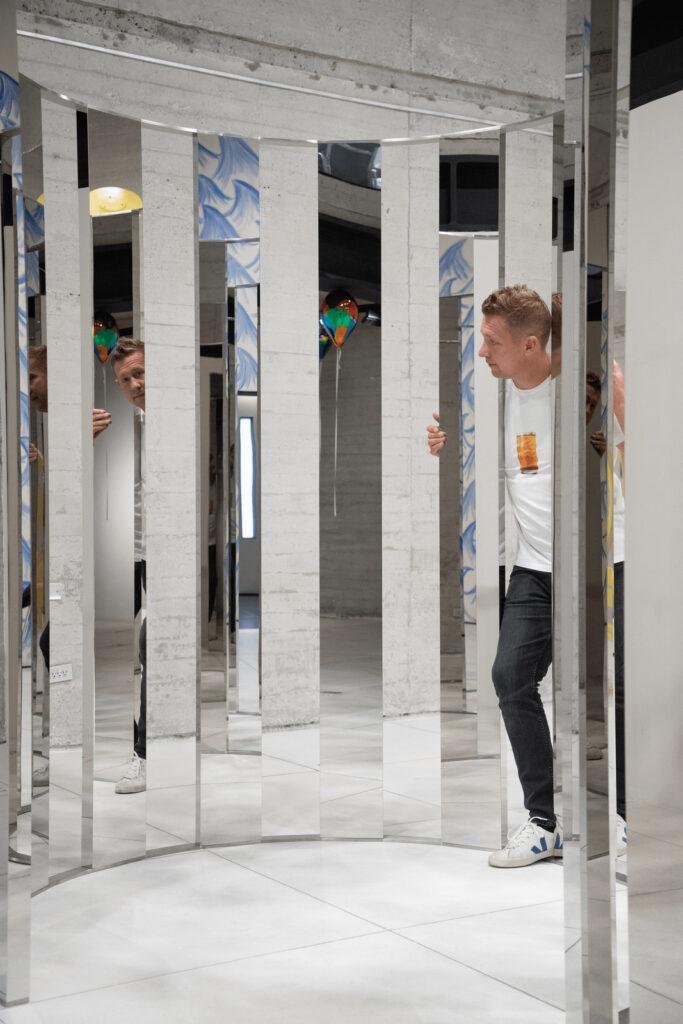
YOU ARE EVERYTHING at Galería RGR.
Photo: Santiago Puente
Mientras estudiabas en la Real Academia de Arte de Dinamarca, creaste una organización sin fines de lucro que organizaba exposiciones en varios lugares de Dinamarca. En ese sentido, siempre has tenido la capacidad de ayudar a los demás a través del arte. ¿Cómo fue esa experiencia? ¿Considerarías volver a hacerlo ahora?
Crecí en Dinamarca, un pequeño país donde la educación es gratuita e incluso financiada por el gobierno, donde las relaciones sociales son muy valoradas, así como también la motivación para crear arte. Además, mis padres, que son hippies que viven en una finca orgánica, me influyeron mucho y me hicieron valorar el diálogo con la gente.
No me consideraría ayudando a los demás, sino ofreciendo una situación de apoyo mutuo, cada uno a su manera. Y sí, aún lo sigo haciendo, por ejemplo: con los proyectos Circus Hein, Karrierebar, Ilovit y mi exposición en la Köngig Galerie, en 2017, y lo volveré a hacer una y otra vez siempre y cuando el tiempo me lo permita.
Tu cuerpo de obra es divertida e interactiva. ¿Por qué es tan importante para ti que los espectadores no se sientan intimidados por las obras de arte y creen encuentros significativos al poder participar e interactuar con ellos?
Más que la percepción pasiva y la reflexión teórica, las experiencias directas y físicas del visitante son importantes para mí. Al ofrecer la posibilidad de participar en la acción de una pieza, mi trabajo agudiza los sentidos de las personas, aumenta la conciencia y percepción de su entorno y fomenta el diálogo entre ellas. Idealmente, mi trabajo fomenta la comunicación y la empatía que las personas transmiten a los demás.
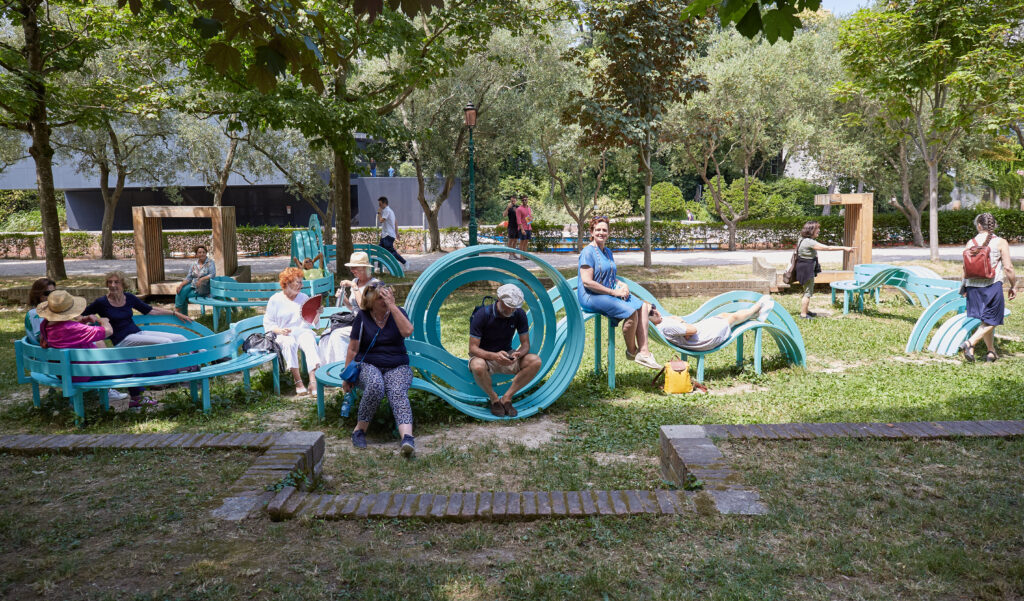
Courtesy KÖNIG GALERIE, Berlin / London, 303 GALLERY, New York, and Galleri Nicolai Wallner, Copenhagen.
Photo: Jan Strempel, exhibited at 58th International Art Exhibition – La Biennale di Venezia, 2019
Has realizado proyectos de arte público. ¿Cómo crees que el arte puede transformar el espacio en el que vivimos y hacer que el arte contemporáneo sea más accesible y democrático para el público?
Las obras de arte en el espacio público abren nuevas posibilidades para que las personas pierdan la timidez hacia el arte, mientras que en los museos y galerías la relación entre el espectador y la obra de arte ya está definida en gran medida.
Cuando la gente ve una obra de arte desarrollada e integrada en el espacio público, a menudo es más fácil para ellos obtener un primer acceso a ella y, por lo tanto, su enfoque del arte en general cambia. Sin embargo, esto no significa que pierdan el respeto por la obra de arte. Ocurre justo lo contrario. Las personas integran más esta experiencia en sus vidas. Al llevar esta nueva experiencia y conciencia a sus vidas, esto probablemente también cambiará su actitud hacia muchas otras cosas, con suerte, para mejor.
You Are Everything es tu primera exposición en la galería RGR, en la Ciudad de México. ¿Cómo surgió la propuesta de esta muestra?
Estaba muy emocionado porque desde hace mucho tiempo quería mostrar mi trabajo en México. Mi objetivo era exhibir obras de arte que se acercaran a los visitantes en diferentes niveles, activando diversas emociones y fomentando el intercambio mutuo. Por eso, es una especie de mezcla que ilustra el alcance de mi trabajo y la variedad de experiencias que ofrecen.
¿Fue tu primera vez en México?
Sí, fue mi primera vez en México. Era un viaje con el que llevaba soñando desde hace veinte años, y superó todas mis expectativas. La vida, la cultura, los colores y la comida me dejaron boquiabierto y, créanme: ¡Volveré pronto! También para volver a visitar a mis amigos, quienes me dieron esta increíble visión del país y su escena artística.
La exposición inmersiva no solo incluyó una serie de espejos, tus icónicos globos y una silla en espiral amarilla, sino que lo más llamativo eran las olas azules que cubrían un muro completo de la galería. ¿Cuál es la experiencia que pretendes ofrecer al visitante?
Para mí el mar es increíblemente fascinante, su tranquilidad y su poder que parece tan contradictorio. El agua me inspira, por eso me gusta pintar acuarelas y me encanta surfear. Pintar ondas es uno de mis ejercicios de meditación, ya que se asemeja a la forma en que nuestra respiración atraviesa nuestro cuerpo. Se trata de un equilibrio en la vida, tienes que ir con la naturaleza, de lo contrario serás derrumbado.

Courtesy KÖNIG GALERIE, Berlin / London, 303 GALLERY, New York, Galleri Nicolai Wallner, Copenhagen, and Galeria RGR, Mexico City,
Photo: INAKS
Hace diez años comenzaste el proyecto Breath With Me. Cuénteme más sobre cómo este proyecto ha ayudado a otras personas.
La respiración consciente se convirtió en un elemento importante en mi nueva vida, después de que experimenté un colapso personal hace casi diez años. La conciencia con mi respiración me permite equilibrar el cuerpo y la mente en todas las circunstancias de la vida. Un ejemplo crucial de este equilibrio se puede encontrar en mi trabajo titulado: Breathing Watercolors. La respiración guía los trazos de la acuarela, para crear un patrón repetitivo de rayas azules verticales pintadas sobre un papel blanco o una pared. Cada línea representa un golpe de respiración.
El color es intenso y vigoroso al comienzo de cada trazo, pero se desvanece gradualmente hacia el fondo. Cada raya significa el proceso de inhalar o exhalar con plena conciencia. Inicialmente, pinté Breathing Watercolors para mí mismo –como parte de mi diario de acuarela o como enormes pinturas murales–. Después, comencé a pedir a los visitantes que se unieran a pintar su respiración también. Al hacerlo, trato de alentar a las personas a que se concentren en su cuerpo y mente en el momento presente, y al mismo tiempo, a poder entablar un diálogo interno.
Al pintar su propia respiración en un medio, no solo podrán experimentar su respiración, cuerpo y mente en el aquí y ahora, sino que también serán parte de un momento experimentado colectivamente con su entorno. Breath With Me son acuarelas pintadas por el público que visualizan lo invisible, nuestra respiración y la relación resultante entre nosotros, recordándonos que debemos cooperar si queremos compartir este mundo juntos hoy y en el futuro.

Photo: Studio Jeppe Hein / Jan Strempel
¿Consideras que el arte es una forma terapéutica constructiva de canalizar tus emociones? En su experiencia, ¿cómo cree que ver y crear arte puede ser una herramienta para mejorar nuestra salud mental?
En general, creo que es muy importante preguntarse y escucharse dentro sí mismo: ¿Cómo estoy realmente? ¿Cómo me siento ahora mismo? Y, sobre todo, en estos tiempos, que son diferentes para todos –más estresantes, preocupantes, inciertos, etc.– Es fundamental saber siempre dónde estoy ahora mismo. Por lo tanto, muchas de mis obras de arte, alientan a los espectadores a cuestionar, reflexionar, expresar o visualizar su estado de ánimo, tal como se sienten en el momento de experimentar una obra de arte.
Además, el arte puede resultar muy atractivo para las personas, creando situaciones alegres, así como momentos de relajación y oportunidades de interacción con otros. La vida es más fácil con una sonrisa en el rostro, o como dijo Charlie Chaplin: “Un día sin risas es un día perdido”. Considero que, si una obra de arte es capaz de dibujar una sonrisa en tu rostro y ponerte de buen humor, incluso mejora tu vida, al menos momentáneamente.
¿En qué estás trabajando actualmente?
En dos proyectos importantes: una exposición individual en el Moderna Museet, en Estocolmo, que se inaugurará en mayo de 2022, y otro proyecto en solitario que estará a la vista en varios lugares del mundo durante el transcurso del año, y será anunciado en marzo de 2022.
¿Qué podemos esperar de Jeppe Hein en un futuro próximo?
No tengas expectativas, mantente abierto a todo.
______________________________________________________________________________
Jeppe Hein: nothing is what it seams
By Sheilla Cohen
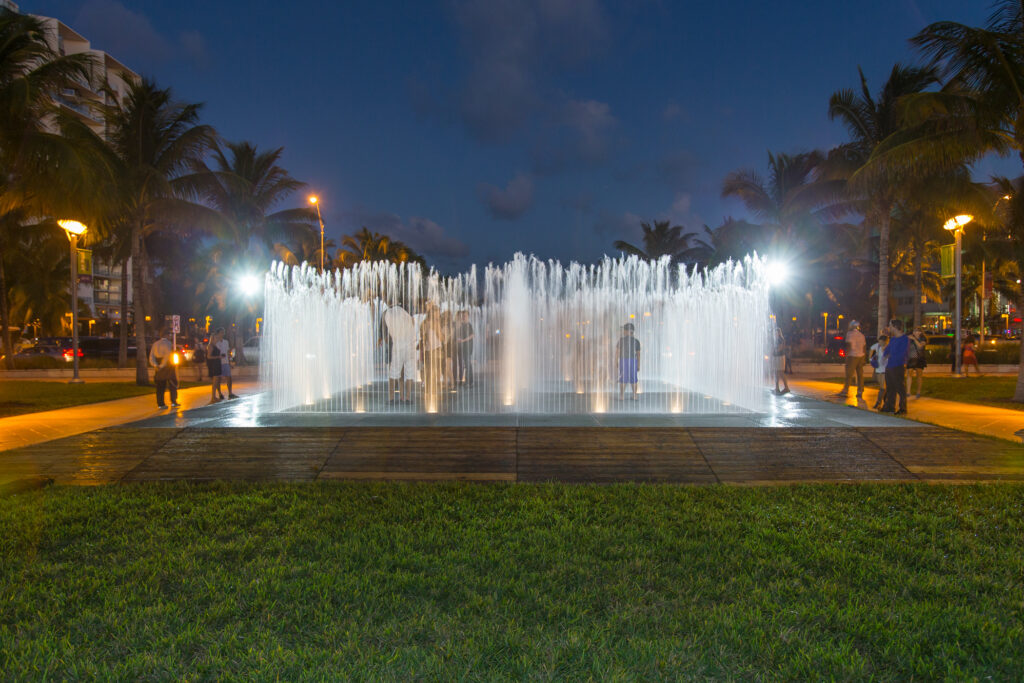
Courtesy KÖNIG GALERIE, Berlin / London, 303 GALLERY, New York, and Galleri Nicolai Wallner, Copenhagen.
Photo: Silvia Rose, exhibited at Art Basel Miami Beach, 2013.
Jeppe Hein (Copenhagen, Denmark, 1974) is widely recognized for his production of experiential and interactive artworks that combine art, architecture and technical inventions. His pieces often feature surprising and captivating elements that place spectators at the centre of events and focus their experience and perception of the surrounding space –hence the recurrent use of mirrors–. In that sense, the distortion of space that can be seen on the surface of his iconic mirror balloons reaffirms the idea that our gaze is under constant transformation.
Instead of being passive spectators, his work incites an active participation of the viewers by inviting them into an interactive experience that allows them to engage with the artworks and letting be emotionally transformed by them.
Aside from his annual production of artworks for art fairs, exhibition and public art projects, he has become really invested in his project “Breath With Me”, which is a watercolor conscious breathing workshop that encourage o focus on their body and mind at the present moment and to enter into an inner dialogue. By painting their own breath onto a medium, they will not only be able to experience their breath, body and mind in the here and now, but also be part of a collectively experienced moment with their environment.
“Life begins with an inhale and ends with an exhale. In-between we all breathe and live different lives. And yet, each breath keeps us together, connected, sharing the same air.”
Through these breathing watercolor workshops, he has taught people from around the globe to learn the benefits from working with both disciplines in order to release the anxiety, stress and tension we suffer from the uncertain times we are living nowadays and remain in the present. That being said, Jeppe Hein’s democratic intentions are to a large extent that contemporary art becomes more accessible and resourceful for everyone despite their knowledge, playing more with our perception and appealing directly to our emotions.
When and how did you decided you wanted to become an artist?
I come from a very creative family and I was surrounded by a lot of art and artists. When I did my first watercolour in 1991, I realized that making art gives me enormous energy and I decided to become an artist myself.
When did you knew sculpture and installation was your medium of choice?
When I created and exhibited my first interactive installation, Moving Wall #1 in 1999 in Frankfurt. When I saw how people interacted, how much they wanted to communicate with the help of my artwork. I made me so happy that it worked as intended and beyond.
Your work is considered a mix of conceptualism and minimalism. Which are the main artistic influences in your work?
I have been inspired by Dan Graham, Robert Morris, Robert Smithson, Larry Bell, Olafur Eliasson and Asger Jorn, because they are all working with communication and experience. Their works are always physically present and perceptible; people shall not only look at them but also feel them.
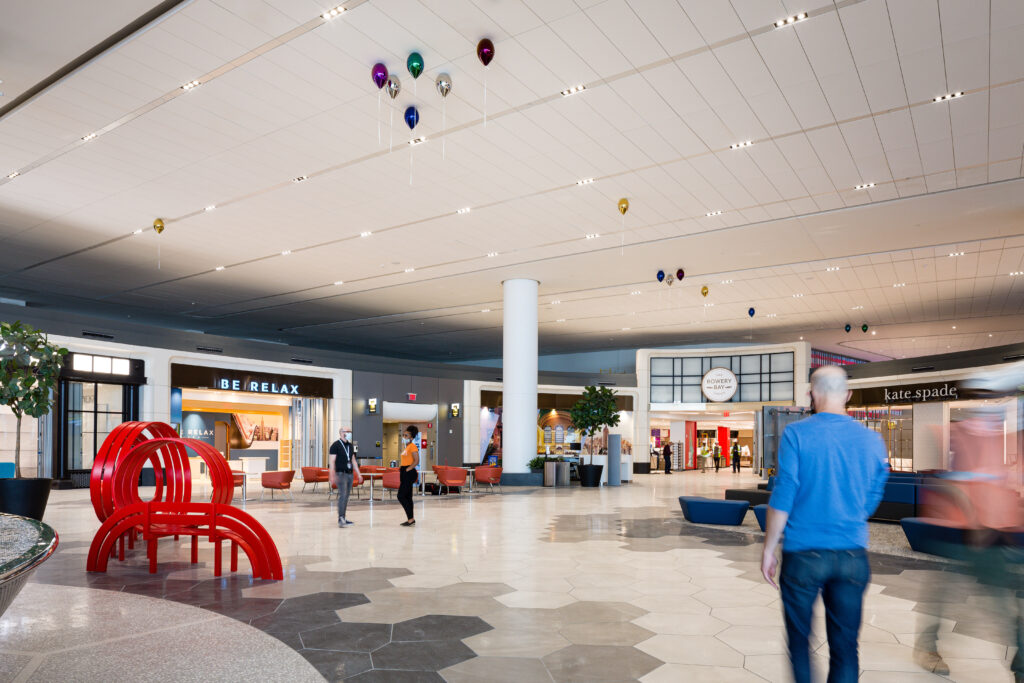
Courtesy KÖNIG GALERIE, Berlin / London, 303 GALLERY, New York, and Galleri Nicolai Wallner, Copenhagen.
Photo: Nicholas Knight, permanent installation at LaGuardia Airport’s Terminal B,
New York City.
Where do you find inspiration?
You need a free mind and body the be inspired and creative, which I experience either when I am far away from the art world, during meditation or when I am in a brainstorming with my team.
How do you think you both as a person and an artist have evolved throughout the years?
I realized that it is important to be right here right now and that you can only change yourself.
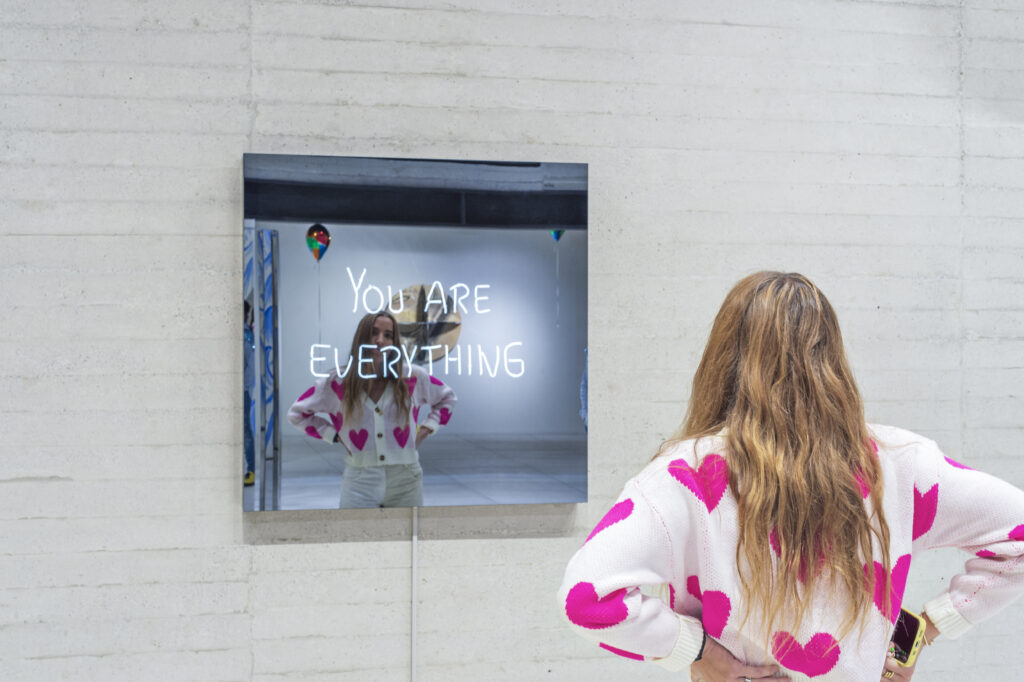
Courtesy KÖNIG GALERIE, Berlin / London, 303 GALLERY, New York, Galleri Nicolai Wallner, Copenhagen, and Galeria RGR, Mexico City
Photo: INAKS
While you were a student at the Royal Danish Academy of Art, you created also a non-commercial organization that put together exhibitions at various venues around Denmark. In that sense, you’ve always had that ability to help others through art. How was that experience and would you consider doing it again now?
I grew up in Denmark, a small country where education is free and even financially supported, where social relationships in the society are highly valued and so is the motivation to create art. In addition, my parents, who are hippies living on an organic farm, influenced me a lot and made me value the dialogue with people. I would not consider myself helping others, rather offering a situation of mutual support, each in our own way. And yes, I still do it, for example with the projects Circus Hein, Karrierebar, ILOVIT, and my exhibition at KÖNGIG GALERIE in 2017, and I will be doing it again and again when my time allows…
Your body of work is very both humorous and interactive. Why is it so important for you that the viewers don’t feel intimidated by the artworks and create meaningful encounters by being able to engage and interact with them?
Rather than passive perception and theoretical reflection, the visitor’s direct and physical experiences are important to me. By offering the possibility of participation in the action of a piece, my work sharpens people’s senses, raise their awareness and perception of their surroundings and encourage a dialogue between them. Ideally, my work fosters communication and empathy that people pass on to others.
You’ve made quite a lot of public projects. How to you think art can transform the space in which we live and make contemporary art more accessible and democratic to the public?
Artworks in public space open up new possibilities for people to lose their timidity towards art, while in museums and galleries the relationship between the viewer and the artwork is already defined to a strong degree. When people see an art piece developed and integrated in public space, it is often easier for them to get a first access to it and thus their approach to art in general changes.
This does not mean that they loose the respect for the artwork though. The opposite is the case. People integrate this experience more into their lives. By carrying this new experience and awareness into their lives, this will probably change their attitude towards many other things also – hopefully to the better.

Courtesy KÖNIG GALERIE, Berlin / London, 303 GALLERY, New York, and Galleri Nicolai Wallner, Copenhagen.
Photo: Tobias Hutzler, exhibited at Brooklyn Bridge Park, NYC, 2015, Courtesy Public Art Fund.
“You Are Everything” at RGR gallery is your first exhibition in Mexico. How did the proposal of this show came up?
I was extremely excited, because I wanted to show my work in Mexico for a long time. My aim was to exhibit artworks that approach visitors on different levels, activate various emotions and encourage mutual exchange. That’s why it is a kind of a mix that illustrates the scope of my work and the variety of experiences they offer.
Was it your first time in Mexico? If so, how was your experience so far?
Yes, it was my first time in Mexico. A travel that I dreamt of for 20 years. It has exceeded all my expectations, the life, the culture, the colours and the food blew me away and I will definetly come back soon. Also to visit my friends again, who gave me this incredible insight into the country and its art world.
The immersive exhibition not only included a series of mirrors, but also your infamous balloons, and a spiral yellow chair, but the most striking thing; was the blue waves that covered an entire wall of the gallery. What is the experience you intended to offer the visitor?
For me the sea is incredibly fascinating, its tranquility and its power that seems so contradictory. Water inspires me that’s why I like painting watercolours and love surfing a lot. Painting waves is one of my meditative exercises as it resembles the way our breath is going through our body. It is all about balance in life, you need to go with the nature otherwise you will be knocked down.

Courtesy KÖNIG GALERIE, Berlin / London, 303 GALLERY, New York, Galleri Nicolai Wallner, Copenhagen, and Galeria RGR, Mexico City
Photo: INAKS.
Ten years ago, you experienced a breakdown and started “Breath With Me”. A participatory art project for the world, in which people paint blue watercolor lines while doing a breathing exercise. Tell me more about the experience you went through and how has this project helped other people managing the anxiety and stress?
Conscious breathing became an important element in my new life, after I experienced a personal breakdown almost ten years ago. The awareness with my breath enables me to balance out the body and mind in all circumstances of life. A crucial example of this balance can be found in my work entitled Breathing Watercolours. Breath guides the strokes of the watercolour, to create a repetitive pattern of vertical blue stripes painted onto a white paper or wall. Each line represents one breath stroke.
The colour is intense and vigorous at the beginning of each stroke, but gradually fades towards the bottom. Each stripe signifies the process of breathing in or breathing out in full awareness. Initially, I painted Breathing Watercolours by myself – as part of my watercolour diary or as huge wall paintings. Then I began to ask visitors to join in painting their breath too. In doing so, I try to encourage people to focus on their body and mind at the present moment and to enter into an inner dialogue.
By painting their own breath onto a medium, they will not only be able to experience their breath, body and mind in the here and now, but also be part of a collectively experienced moment with their environment.
Breathe with Me are Breathing Watercolours painted by the public that visualize the invisible –our breath and the resultant relation between us– reminding us to cooperate if we want to share this world together today and in the future.
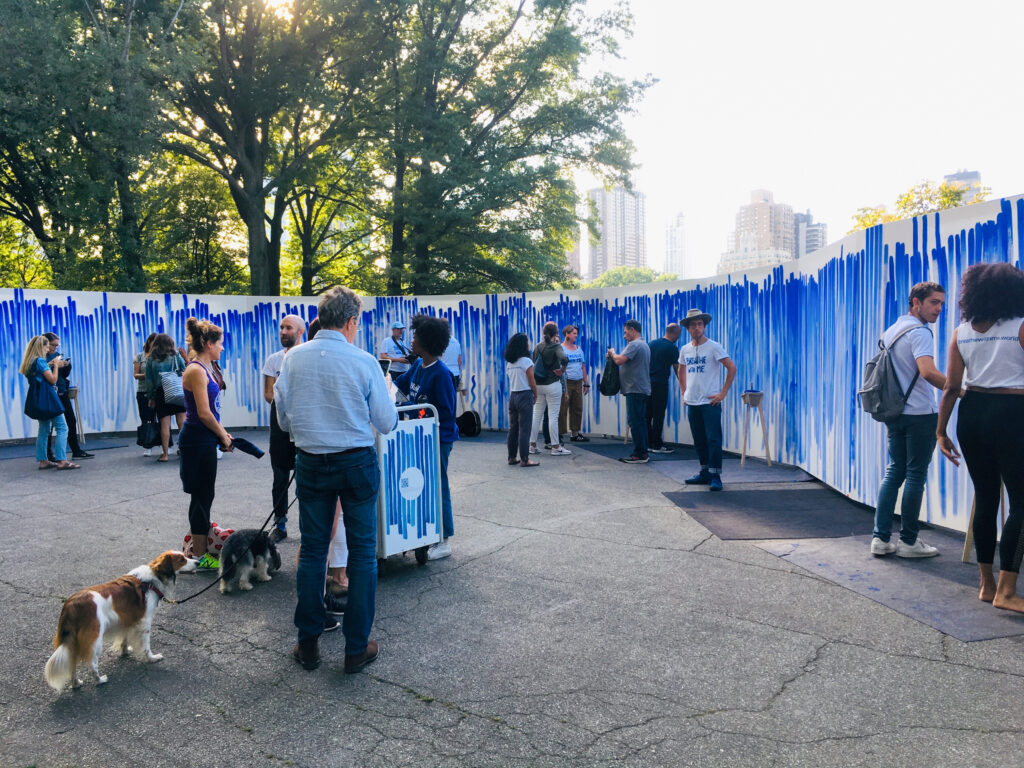
Photo: Studio Jeppe Hein / Jan Strempel
Do you believe art is a therapeutic constructive way to channel your emotions? In your experience, how do you find seeing and creating art can be a tool for improving our mental health?
In general, I think it’s very important to ask yourself and to listen within yourself: How am I actually doing? How do I feel right now? And especially in these times, which are different for all of us – more stressful, worrying, uncertain – it is essential to always look at where am I right now. Thus, many of my artworks encourage viewers to questioning, reflecting, expressing, or visualizing their mood, just as they feel in the moment of experiencing an artwork.
In addition, art can be very appealing for people, creating joyful situations as well as relaxing moments and opportunities for interaction with other people. Art makes people laugh and life is easier with a smile on your face – or as Charlie Chaplin said: «A day without laughter is a day wasted.» I believe if an artwork puts a smile on your face and gets you in high spirits, it even makes your life better – at least momentarily.
What are you currently working on?
I am currently working on two major projects: a solo show at Moderna Museet in Stockholm, Sweden that will open up in May 2022 and another solo project that will be on view in several places worldwide during the course of the year, but will only be announced in March 2022.
What can we expect from Jeppe Hein in the near future?
DON’T’ EXPECT ANYTHING BE OPEN FOR EVERYTHING.
Jeppe Hein: No todo es lo que parece
